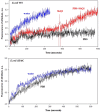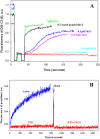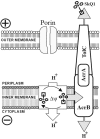Mitochondria-targeted antioxidants as highly effective antibiotics
- PMID: 28469140
- PMCID: PMC5431119
- DOI: 10.1038/s41598-017-00802-8
Mitochondria-targeted antioxidants as highly effective antibiotics
Abstract
Mitochondria-targeted antioxidants are known to alleviate mitochondrial oxidative damage that is associated with a variety of diseases. Here, we showed that SkQ1, a decyltriphenyl phosphonium cation conjugated to a quinone moiety, exhibited strong antibacterial activity towards Gram-positive Bacillus subtilis, Mycobacterium sp. and Staphylococcus aureus and Gram-negative Photobacterium phosphoreum and Rhodobacter sphaeroides in submicromolar and micromolar concentrations. SkQ1 exhibited less antibiotic activity towards Escherichia coli due to the presence of the highly effective multidrug resistance pump AcrAB-TolC. E. coli mutants lacking AcrAB-TolC showed similar SkQ1 sensitivity, as B. subtilis. Lowering of the bacterial membrane potential by SkQ1 might be involved in the mechanism of its bactericidal action. No significant cytotoxic effect on mammalian cells was observed at bacteriotoxic concentrations of SkQ1. Therefore, SkQ1 may be effective in protection of the infected mammals by killing invading bacteria.
Conflict of interest statement
The authors declare that they have no competing interests.
Figures








Similar articles
-
Rhodamine 19 Alkyl Esters as Effective Antibacterial Agents.Int J Mol Sci. 2024 Jun 2;25(11):6137. doi: 10.3390/ijms25116137. Int J Mol Sci. 2024. PMID: 38892325 Free PMC article.
-
An attempt to prevent senescence: a mitochondrial approach.Biochim Biophys Acta. 2009 May;1787(5):437-61. doi: 10.1016/j.bbabio.2008.12.008. Epub 2008 Dec 29. Biochim Biophys Acta. 2009. PMID: 19159610 Review.
-
Antioxidant mechanism of mitochondria-targeted plastoquinone SkQ1 is suppressed in aglycemic HepG2 cells dependent on oxidative phosphorylation.Biochim Biophys Acta Bioenerg. 2017 Sep;1858(9):750-762. doi: 10.1016/j.bbabio.2017.05.005. Epub 2017 May 26. Biochim Biophys Acta Bioenerg. 2017. PMID: 28554565
-
Mitochondria-targeted plastoquinone derivatives as tools to interrupt execution of the aging program. 3. Inhibitory effect of SkQ1 on tumor development from p53-deficient cells.Biochemistry (Mosc). 2008 Dec;73(12):1300-16. doi: 10.1134/s0006297908120031. Biochemistry (Mosc). 2008. PMID: 19120016
-
A biochemical approach to the problem of aging: "megaproject" on membrane-penetrating ions. The first results and prospects.Biochemistry (Mosc). 2007 Dec;72(12):1385-96. doi: 10.1134/s0006297907120139. Biochemistry (Mosc). 2007. PMID: 18205623 Review.
Cited by
-
Triphenylphosphonium Analogs of Short Peptide Related to Bactenecin 7 and Oncocin 112 as Antimicrobial Agents.Pharmaceutics. 2024 Jan 22;16(1):148. doi: 10.3390/pharmaceutics16010148. Pharmaceutics. 2024. PMID: 38276518 Free PMC article.
-
Conjugates of Chloramphenicol Amine and Berberine as Antimicrobial Agents.Antibiotics (Basel). 2022 Dec 22;12(1):15. doi: 10.3390/antibiotics12010015. Antibiotics (Basel). 2022. PMID: 36671216 Free PMC article.
-
Two-faced Janus SkQ1/SkQR1: patterns and molecular volume threshold for substrate recognition by the AcrAB-TolC pump.Front Pharmacol. 2025 Mar 6;16:1480955. doi: 10.3389/fphar.2025.1480955. eCollection 2025. Front Pharmacol. 2025. PMID: 40115260 Free PMC article. No abstract available.
-
Nongenotoxic ABCB1 activator tetraphenylphosphonium can contribute to doxorubicin resistance in MX-1 breast cancer cell line.Sci Rep. 2021 Mar 22;11(1):6556. doi: 10.1038/s41598-021-86120-6. Sci Rep. 2021. PMID: 33753859 Free PMC article.
-
Trialkyl(vinyl)phosphonium Chlorophenol Derivatives as Potent Mitochondrial Uncouplers and Antibacterial Agents.ACS Omega. 2021 Jul 29;6(31):20676-20685. doi: 10.1021/acsomega.1c02909. eCollection 2021 Aug 10. ACS Omega. 2021. PMID: 34396013 Free PMC article.
References
-
- Pernak, J., Jedraszczyk, J., Krysiński, J. Quaternary ammonium- and phosphonium compounds against bacteria and fungi. Pharmazie42, 10, 703–704 German (1987). - PubMed
-
- Cieniecka-Rosłonkiewicz A, et al. Synthesis, anti-microbial activities and anti-electrostatic properties of phosphonium-based ionic liquids. Green Chem. 2005;7:855–862. doi: 10.1039/b508499g. - DOI
Publication types
MeSH terms
Substances
LinkOut - more resources
Full Text Sources
Other Literature Sources
Medical

